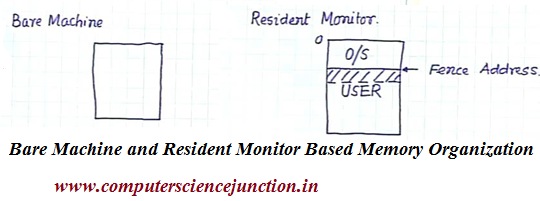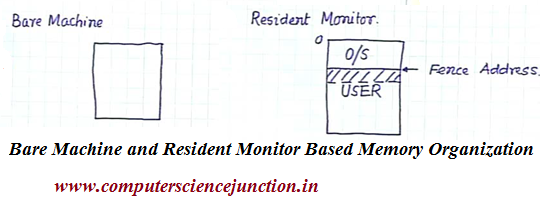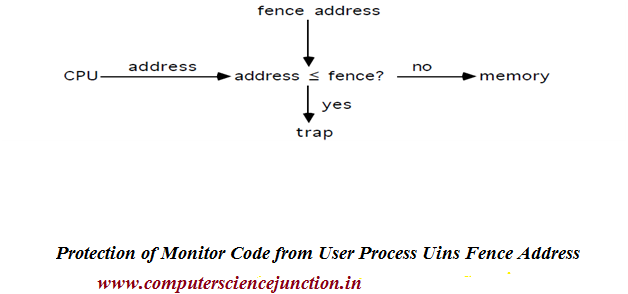Bare Metal Machine and Resident Monitor
Bare metal machine based this tutorial covers the concept of resident monitor and bare machine or bare metal machine in operating system.
Objective of this tutorial is to providing knowledge about how the memory is organized using bare machine or bare metal machine and in resident monitor approach.
I preferred Operating System Concepts: By Galvin for the study of Bare machine and Resident monitor
Questions and Answers
This bare metal machine and resident monitor based tutorial will be helpful to computer science graduate for getting the answer of the following questions.
- What is resident monitor ?
- What is bare machine ?
- What are feature of bare metal machine or bare machine system ?
- What do you mean by bare metal machine ?
- How the memory is organized in bare machine and resident monitor ?
- What is fence address ?
- What do you understand by protection of resident monitor or kernel?
- Which memory locations are assigned to Resident or OS ?
- What is user address space ?
- What is logical address ?
Bare Metal Machine
The simplest variety of organization of main memory is bare machine. Bare machine system is also known as bare metal machine.
In bare machine or bare metal machine the complete memory is given to the designer. There is no partition within the memory. Currently it’s up to the designer to make a decision that a part of the memory can contain the monitor .
This part of the memory are going to be used for storing of temporary knowledge, for storage of information, for storage of processed knowledge, everything.
So everything must be set by the system designer in case of bare machine or bare metal machine. Typically this is often the sort of memory organization that is employed for implementation of dedicated systems that’s if I wished to style a laptop that isn’t to be used for general purpose computing.
I will have a laptop for dominant some power house or for dominant some method. in this case the pc that I will be able to use for that operation, I will be able to not wish that laptop to try and do any general purpose computation.
Some features or characteristics of bare metal machine or bare machine are as follow :
- No Protection.
- No Overhead.
- Simplest variety of memory management.
- User have complete control and operating system has none.
- This is used by hardware diagnostics, by the system boot code, real time/dedicated system, maximum flexibility to user and minimum hardware cost.
- No operating system service. It means OS manage nothing instead of its entire address space is given to the program and all the managing left to it.
Figure 1: Bare Machine and Resident Monitor Based Memory Organization
Resident Monitor
In this section we are going to discuss concerning resident monitor in operating system or resident monitor in memory management. In case of resident monitor system, the for the memory organization , memory is partitioned or divided into 2 partitions.
One among the partition or memory portion having starting addresses is occupied by the Operating System or OS Code. This operating system code some time also known as kernel or resident monitor. Kernel or resident monitor is the actually portion where all the functionalities of operating system are defined or coded.
Second memory partition other than the kernel space or resident monitor space is known as user address space. User’s program or application are loaded in this portion of memory or user address space.
User program mustn’t be able to modify something into the monitor space of the memory. Therefore what we have a tendency to primarily would like is protection of the resident monitor or protection of the kernel against any user program.
So how kernel or resident monitor is protected from user program ?
Fence address is the boundary address at where resident monitor address space ends and user address space starts from the address just after the fence address. This fence address protect the resident monitor.
Whenever the user program tries to access any of the memory location and the program can generate the address of the memory location that is to be accessed. This address is generated by CPU and also know as logical address.
This logical address is compared with the value of fence address as shown in following figure.
Figure 2: Protection of Monitor Space using fence address.
Must check every memory reference against fence ( mounted or variable ) in hardware or register.
If user generated address or logical address < fence address, then illegal access. or invalid address. This represents that user program is trying to access the resident monitor part or kernel.
So an error or trap is generated and the access is not allowed. In this way resident monitor keep safe from user program.
If the address generated by the CPU or user program address is greater than the fence address then this is a valid access and access is allowed.
Keywords: definition of resident monitor, what is bare machine, definition of fence address,logical address,memory, operating system code protection , user process, resident monitor in os, resident monitor in operating system, basic bare machine in memory management.
Next Tutorial – Dynamic Relocation in Memory Management








